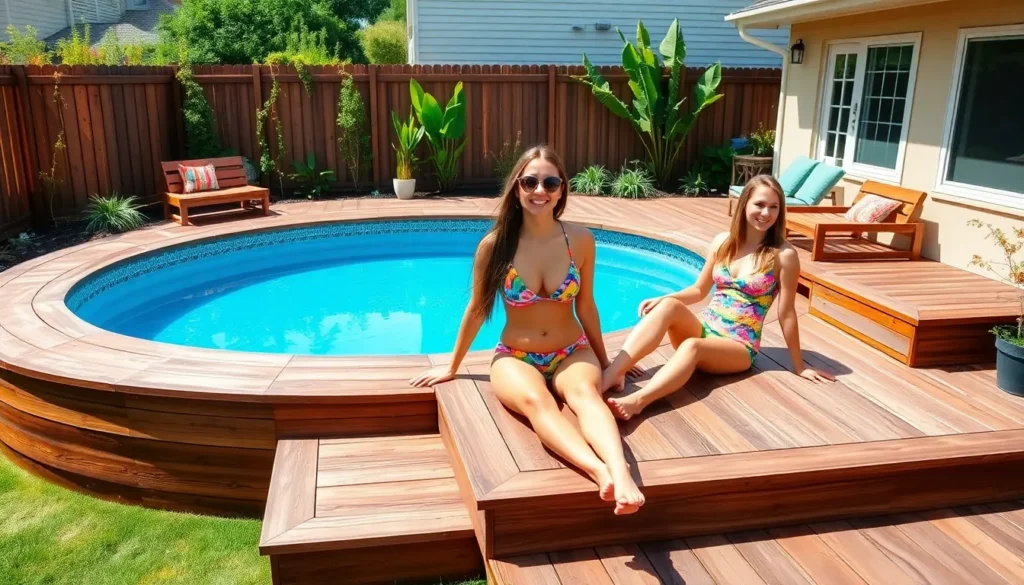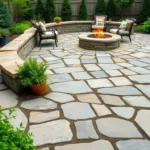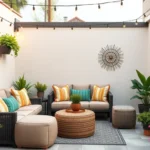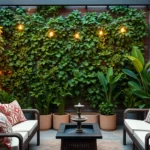Transforming your backyard with a small above ground pool doesn’t mean sacrificing style or functionality. We’ve discovered that the right deck design can turn even the most compact pool setup into a stunning outdoor oasis that rivals expensive in-ground installations.
Small above ground pools present unique opportunities for creative deck answers that maximize both space and visual appeal. Whether you’re working with a tight budget or limited square footage we’ll show you how smart design choices can create the perfect poolside retreat.
From multi-level platforms to integrated seating and storage answers we’ve compiled the most innovative deck ideas that prove size doesn’t limit your design potential. These carefully selected concepts will help you create a beautiful and functional pool area that becomes the centerpiece of your outdoor living space.
Elevated Platform Deck Ideas for Maximum Space Efficiency
Maximizing every square foot becomes crucial when working with limited backyard space. These elevated platform designs help you create stunning pool decks that make the most of your available area.
Single-Level Wraparound Design
Wraparound platforms create the illusion of expansive space by extending around your pool’s perimeter in one continuous level. This design approach maximizes usable deck area while maintaining clean, unbroken sight lines that make your backyard appear larger.
We recommend building the wraparound deck at least 4 feet wide on all sides to provide comfortable walking space and room for pool furniture. Standard composite decking materials work exceptionally well for this application, offering durability with minimal maintenance requirements.
Position the deck height approximately 6 to 12 inches above ground level to create visual separation without overwhelming your pool setup. This elevation also improves drainage and prevents water accumulation around your pool area.
Integrate built-in storage benches along the deck’s outer edges to eliminate the need for separate furniture pieces. These dual-purpose elements provide seating while housing pool supplies, toys, and maintenance equipment.
Multi-Tiered Stepped Platforms
Stepped platform designs create distinct zones around your pool while maximizing vertical space efficiency. Each tier serves a exact purpose, from lounging areas to dining spaces, making your compact pool area feel like a resort destination.
Design the first tier at ground level as your primary pool access point, keeping it 3 to 4 feet wide for safe entry and exit. This level should include non-slip surfaces and proper drainage to handle splash and drip water.
Elevate the second tier 8 to 12 inches higher to create a dedicated seating area with built-in benches or space for lounge chairs. This separation provides privacy for relaxation while maintaining visual connection to the pool.
Add a third tier if space allows, positioned 16 to 20 inches above ground level for dining or entertaining. This highest platform can accommodate a small table and chairs without interfering with pool activities below.
Connect each level with wide, shallow steps that double as additional seating during gatherings. We suggest making steps at least 18 inches deep to ensure comfortable use as both stairs and casual seating.
Corner Installation Maximization
Corner installations make the most of awkward or unused backyard spaces by positioning your pool and deck system in areas that might otherwise remain empty. This strategic placement leaves your main yard open for other activities.
Angle the deck to follow your property lines, creating a custom fit that maximizes every available inch. L-shaped or triangular deck configurations work particularly well in corner installations, providing substantial deck space even though the confined area.
Build outward from the corner using cantilevered sections that extend beyond your pool’s footprint without requiring additional ground support. This technique can increase your usable deck space by 20 to 30 percent in tight corner installations.
Include vertical elements like privacy screens or trellises along the property lines to create an intimate, enclosed feeling. These additions make your corner pool area feel like a private retreat while blocking unwanted views from neighboring properties.
Incorporate diagonal pathways that lead from your main yard to the corner pool area, creating visual flow and making the space feel integrated rather than tucked away. These walkways can be as simple as stepping stones or as elaborate as matching deck materials.
Budget-Friendly DIY Small Pool Deck Solutions
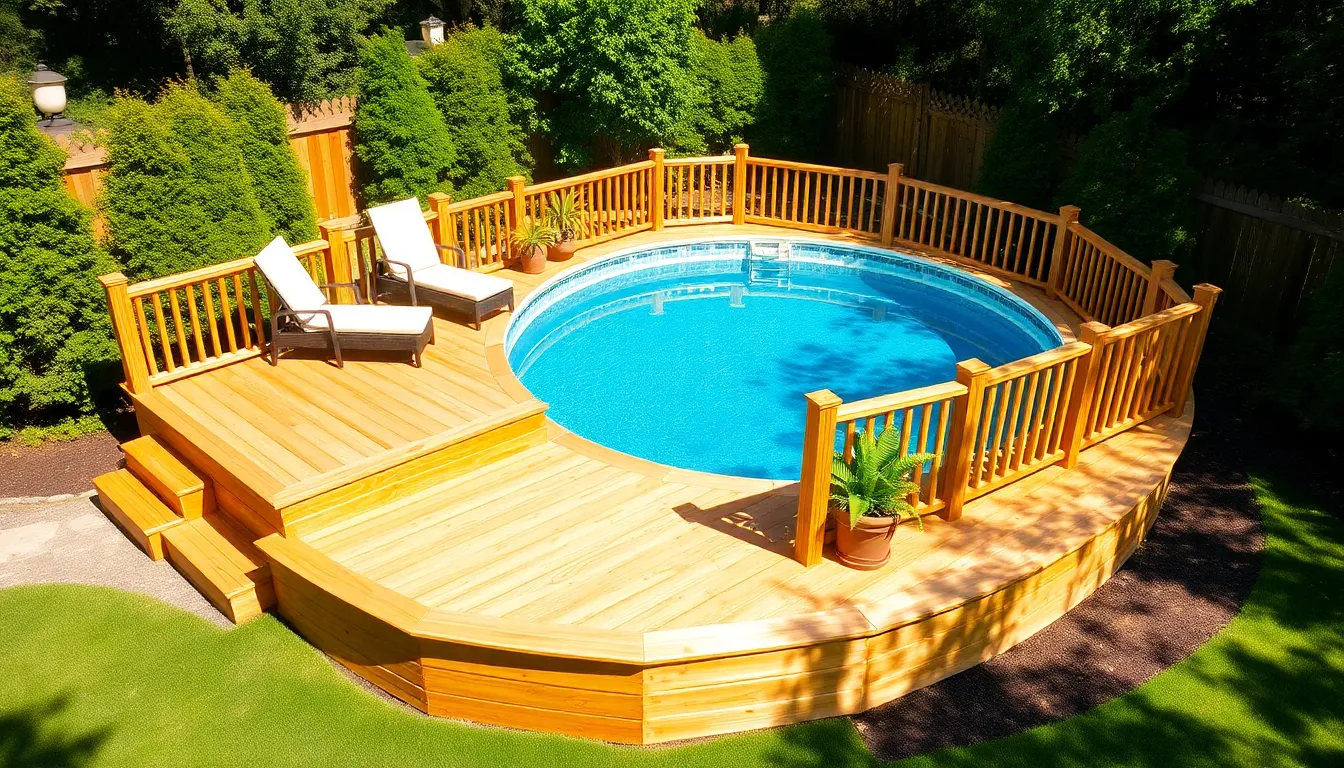
Building an affordable deck doesn’t mean sacrificing style or functionality. We’ve found several cost-effective approaches that deliver professional results without breaking your budget.
Pressure-Treated Lumber Construction
Pressure-treated lumber remains our top recommendation for budget-conscious DIY builders looking to create durable pool decks. This material costs significantly less than premium alternatives while offering excellent moisture and insect resistance essential for poolside environments.
Construction benefits include:
- Frame building made simple with readily available materials
- Structural integrity that supports heavy pool equipment and multiple users
- Installation flexibility allowing custom sizing for any pool configuration
- Maintenance requirements limited to periodic staining or sealing every 2-3 years
We recommend using 2×8 or 2×10 joists spaced 16 inches on center for optimal support. Cedar posts work well for vertical supports when budget allows, though pressure-treated posts provide adequate strength at lower cost.
Composite Decking Alternatives
Composite decking offers long-term value even though higher upfront costs compared to traditional lumber options. These synthetic materials combine wood fibers with recycled plastic to create boards that resist warping, rotting, and splintering.
Key advantages we’ve observed:
- Maintenance elimination removes ongoing staining and sealing expenses
- Color retention prevents fading from pool chemicals and UV exposure
- Slip resistance improves safety around wet pool areas
- Installation speed increases with lighter weight boards and hidden fastener systems
Popular brands like Trex and TimberTech offer 25-year warranties, making the initial investment worthwhile for homeowners planning long-term pool enjoyment.
Recycled Material Options
Recycled materials provide eco-friendly answers that reduce both environmental impact and construction costs. We’ve seen creative homeowners transform salvaged materials into stunning pool deck features.
Effective recycled options include:
- Reclaimed wood planks from demolished buildings or old fences
- Recycled plastic lumber made from post-consumer waste materials
- Repurposed stone and tile creating mosaic accent areas
- Pallet wood sections perfect for smaller deck sections or railings
Combining materials creates visual interest while stretching budgets further. For example, we often suggest using reclaimed wood for decking boards with new pressure-treated lumber for structural framing to balance cost and safety requirements.
Space-Saving Corner and Side Deck Configurations
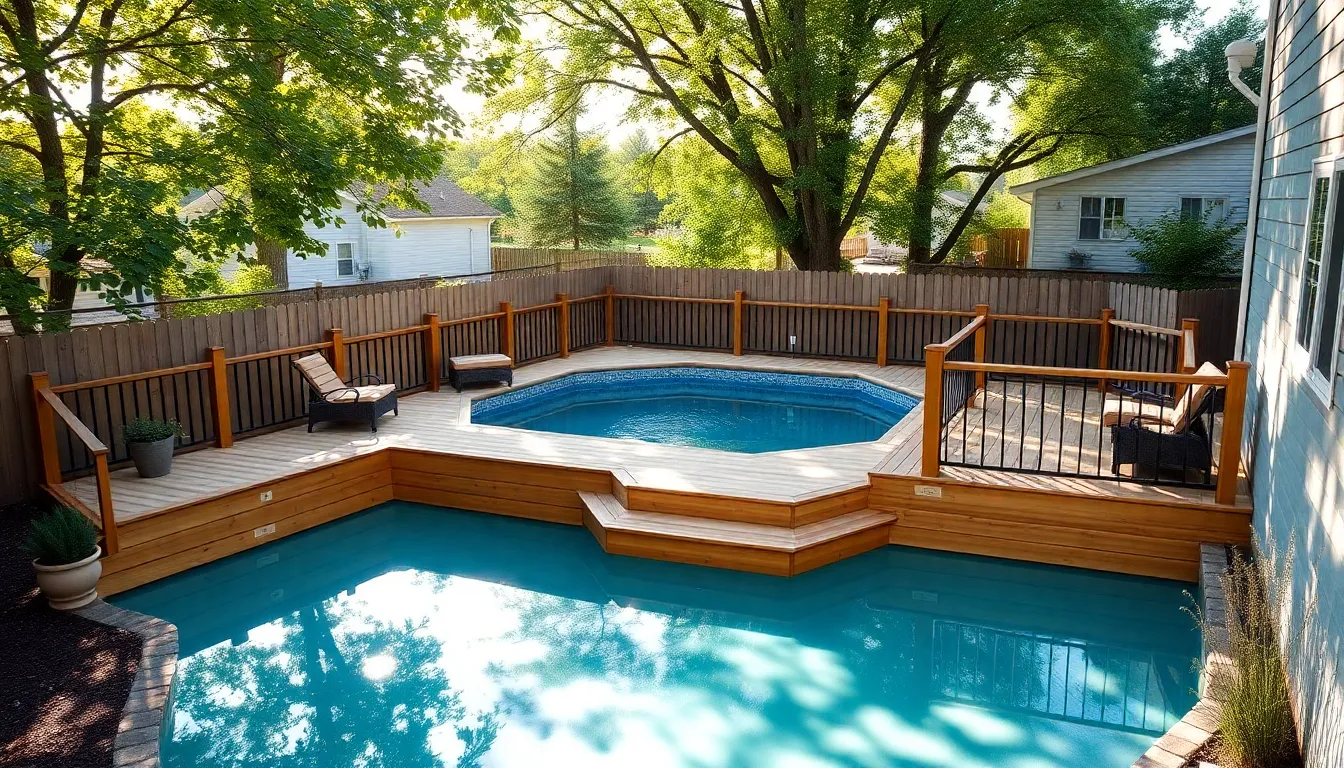
Strategic corner and side deck placement transforms even the tightest spaces into functional poolside retreats. These configurations work perfectly when you’re dealing with property lines, existing structures, or simply want to maximize your backyard’s potential.
L-Shaped Corner Installations
L-shaped decks fit beautifully into corner spaces, wrapping around your above ground pool to create dual access points. This configuration maximizes limited yard space while establishing a cozy lounging area along two sides of your pool.
Design Benefits:
- Creates natural flow between home and backyard
- Provides multiple entry points for convenience
- Establishes distinct zones for different activities
- Utilizes corner spaces that might otherwise go unused
Construction Features:
- Built with pressure-treated lumber or composite materials for durability
- Includes stairs on one or both ends for easy access
- Incorporates safety railings around the perimeter
- Features integrated benches for built-in seating answers
Space Optimization:
- Wraps around the pool’s natural curves
- Creates intimate gathering areas without overwhelming the yard
- Allows for equipment storage underneath the deck structure
- Connects seamlessly to existing outdoor living spaces
Single-Side Access Designs
Single-side decks provide pool access from just one side, making them ideal for tight spaces or when your pool sits against a fence or property line. These designs simplify construction while still delivering full functionality.
Practical Applications:
- Works perfectly in narrow yard configurations
- Saves space by eliminating unnecessary deck area
- Reduces material costs and construction time
- Provides controlled access for safety purposes
Design Elements:
- Typically includes stairs or ladder entry on one side
- Features space for poolside essentials like grills or loungers
- Incorporates seating areas along the deck surface
- Often includes storage answers beneath the platform
Space Efficiency:
- Maximizes swimming area while minimizing deck footprint
- Leaves more yard space for other outdoor activities
- Creates a streamlined, uncluttered appearance
- Allows for easy maintenance and cleaning access
Compact Entry Point Answers
Compact decks focus on essential entry points with minimal space requirements, perfect for smaller pools or extremely limited yards. These answers prioritize function while maintaining safety and style.
Entry Options:
- Straight or curved stairways with safety handrails
- Ladder platforms for quick pool access
- Gated entries for controlled access with children
- Combination stairs and seating in one compact unit
Size Specifications:
- Plans available for 5×6 foot configurations
- 6×8 foot options for slightly larger spaces
- Custom sizing based on exact pool dimensions
- Modular designs that can expand over time
Smart Features:
- Vertical storage under deck platforms
- Integrated pool equipment housing
- Built-in towel bars and accessory hooks
- Slip-resistant surfaces for wet conditions
Cost-Effective Materials:
- Reclaimed wood for rustic aesthetic appeal
- Scrap lumber to reduce overall project costs
- Composite materials for long-term durability
- Combination materials for unique visual interest
These space-saving configurations prove that even the smallest yards can accommodate beautiful, functional pool decks that enhance your outdoor living experience.
Multi-Level Small Above Ground Pool Deck Designs
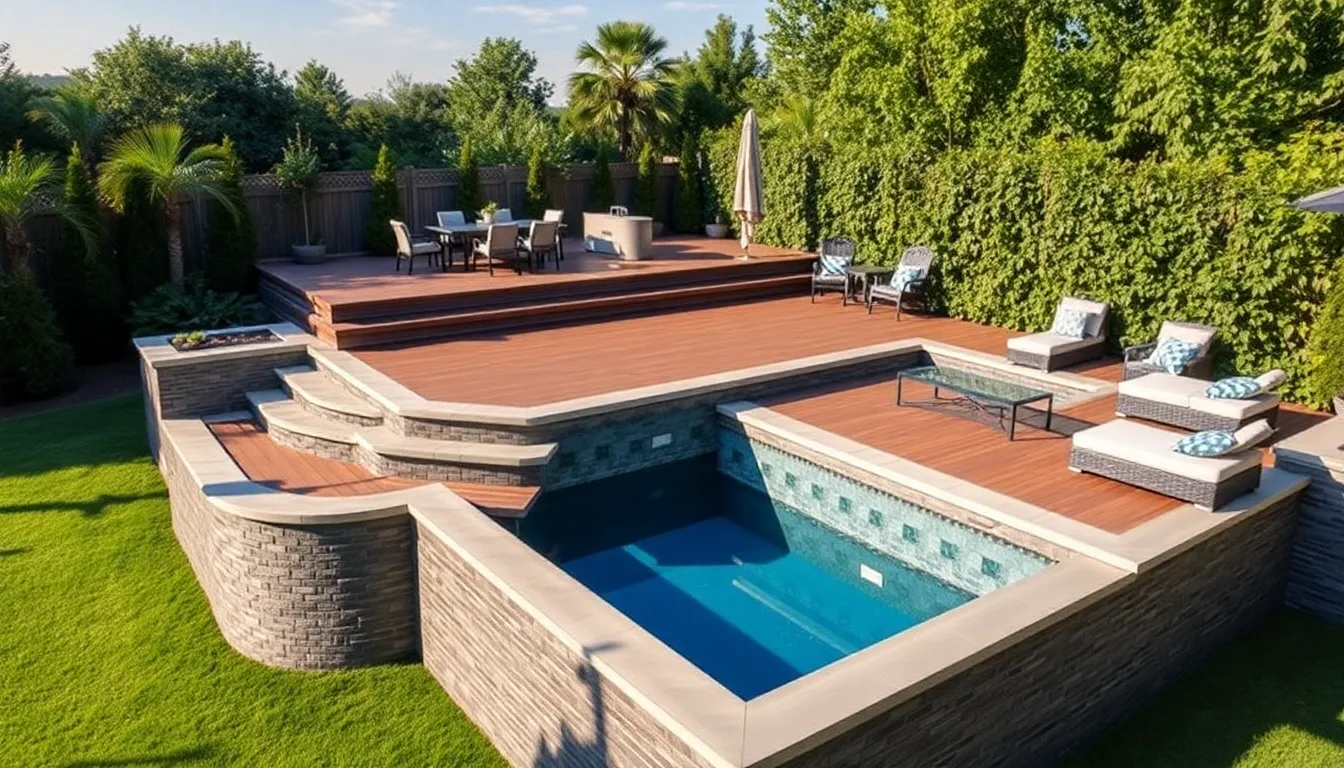
Multi-level designs take your compact pool area from basic to brilliant by creating distinct zones that serve different purposes. These elevated configurations maximize every square foot while delivering the visual impact of much larger installations.
Two-Tier Entertainment Areas
Creating dedicated zones with two-tier designs transforms your poolside experience into a well-organized entertainment space. Upper tiers work perfectly for dining areas or grilling stations, while lower tiers provide direct pool access and wet activities. We recommend positioning the lower platform at pool height for easy entry and exit, then elevating the second tier 18-24 inches above to create natural separation between wet and dry zones.
Functional flow becomes effortless when you design each tier with exact purposes in mind. Lower platforms serve as changing areas and pool equipment storage, while upper decks accommodate seating, dining tables, or outdoor kitchens. This separation prevents water from splashing onto dry entertaining areas and creates natural traffic patterns that guests can follow intuitively.
Stepped Seating Integration
Built-in stepped seating eliminates the need for bulky outdoor furniture while maximizing your deck’s social potential. These integrated steps double as comfortable perches for poolside conversations and create stadium-style viewing areas for pool activities. We suggest constructing steps with 16-18 inch depths to provide adequate seating space without overwhelming your compact deck footprint.
Versatile seating arrangements emerge naturally from stepped deck configurations. Lower steps work as footrests or additional seating for children, while higher steps accommodate adult conversations and provide elevated viewing angles. This approach turns your entire deck perimeter into potential seating, dramatically increasing your entertaining capacity without adding permanent furniture pieces.
Graduated Height Platforms
Variable height platforms create visual interest while solving practical access challenges between your pool, yard, and home. Gradual elevation changes of 6-12 inches between platforms provide comfortable transitions that feel natural and safe. We recommend using these height variations to incorporate different activity zones, such as sunbathing platforms, dining areas, and equipment storage spaces.
Smooth transitions between platforms enhance both safety and aesthetics in your multi-level design. Wider steps between elevation changes accommodate foot traffic and create natural gathering spots, while gradual slopes prevent tripping hazards. These platforms can connect your pool deck to existing patios or extend toward landscaped areas, creating a cohesive outdoor living environment that feels purposefully designed rather than added as an afterthought.
Integrated Storage and Seating Deck Ideas
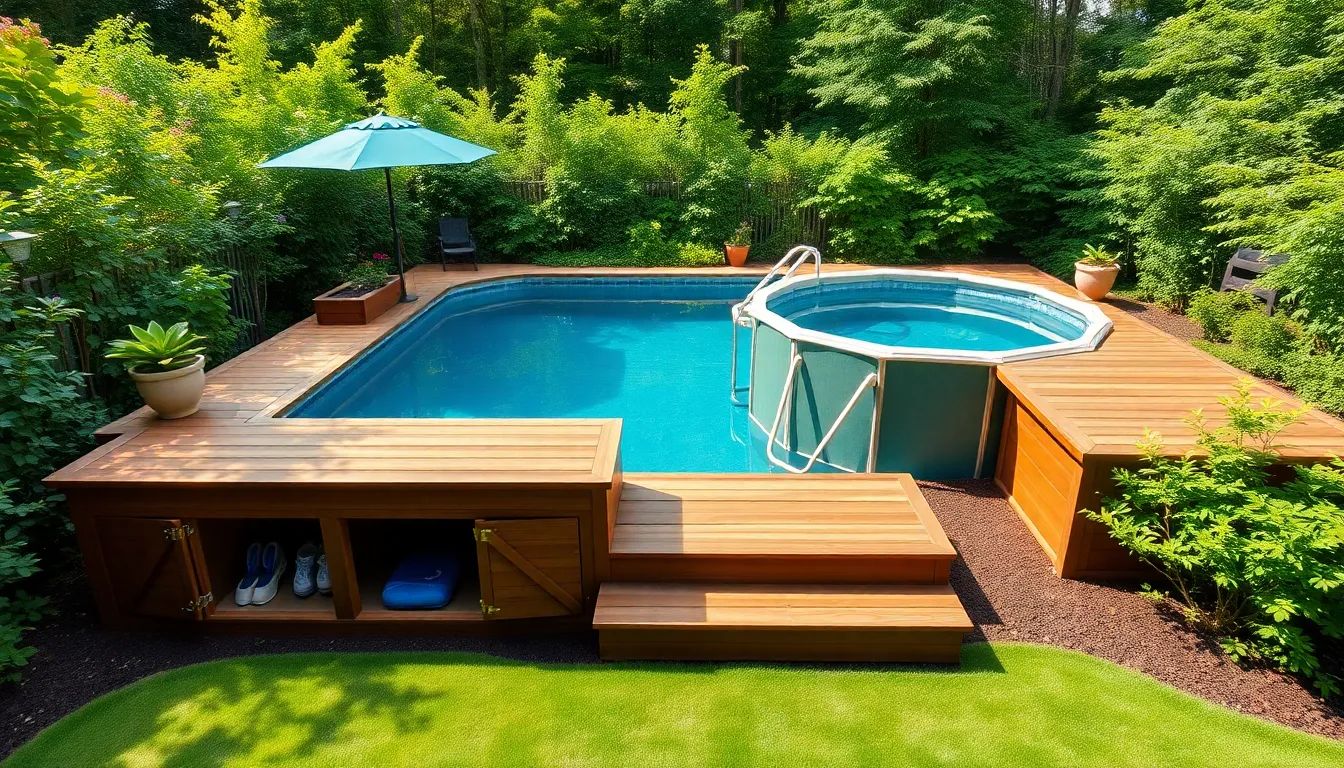
We can transform small above-ground pool decks into highly functional spaces by combining smart storage answers with comfortable seating options. These dual-purpose features maximize every square foot while keeping our poolside area organized and clutter-free.
Built-In Bench Answers
Perimeter benches offer the perfect combination of comfortable seating and hidden storage for pool accessories. We recommend installing these benches along the deck’s perimeter to provide ample seating without sacrificing valuable floor space. Hinged tops allow easy access to towels, pool toys, and cleaning supplies while maintaining a clean aesthetic.
Pull-out drawer systems within bench designs create organized compartments for different pool essentials. These drawer configurations work particularly well for storing smaller items like sunscreen, pool chemicals, and maintenance tools. Construction with pressure-treated lumber ensures durability while keeping costs manageable.
Corner bench configurations maximize seating capacity in L-shaped or wraparound deck designs. We’ve found that positioning benches at deck corners creates natural conversation areas while utilizing space that might otherwise go unused. Storage compartments within these corner units can house larger items like pool floats and umbrellas.
Under-Deck Storage Compartments
Concealed access panels transform the space beneath deck surfaces into valuable storage areas. We install removable panels or hinged doors that blend seamlessly with the deck design while providing access to weather-protected storage. These compartments work exceptionally well for bulky items like pool chemicals, cleaning equipment, and seasonal accessories.
Weatherproof cubby systems create organized zones beneath the deck for different categories of pool equipment. Proper ventilation prevents moisture buildup while keeping stored items dry and accessible. We recommend using marine-grade hardware to ensure long-term functionality in wet conditions.
Integrated drainage answers within under-deck storage prevent water accumulation and protect stored items. Strategic placement of drainage points ensures that any moisture naturally flows away from storage areas. This feature proves particularly valuable for storing electrical equipment and sensitive pool maintenance supplies.
Poolside Equipment Housing
Dedicated pump enclosures hide unsightly pool equipment while maintaining easy maintenance access. We design these enclosures within the deck structure to reduce noise and create a cleaner appearance around the pool area. Ventilation grilles ensure proper airflow while keeping equipment protected from weather and debris.
Filter housing compartments integrate seamlessly into deck designs while providing necessary equipment protection. These dedicated spaces typically feature removable panels for routine maintenance and service access. Sound dampening materials within these enclosures significantly reduce operational noise.
Multi-equipment stations combine storage for pumps, filters, and heaters in single, well-organized units. We position these stations strategically to minimize plumbing runs while maintaining aesthetic appeal. Access doors and proper ventilation ensure equipment longevity while keeping maintenance simple and straightforward.
Low-Maintenance Decking Material Options
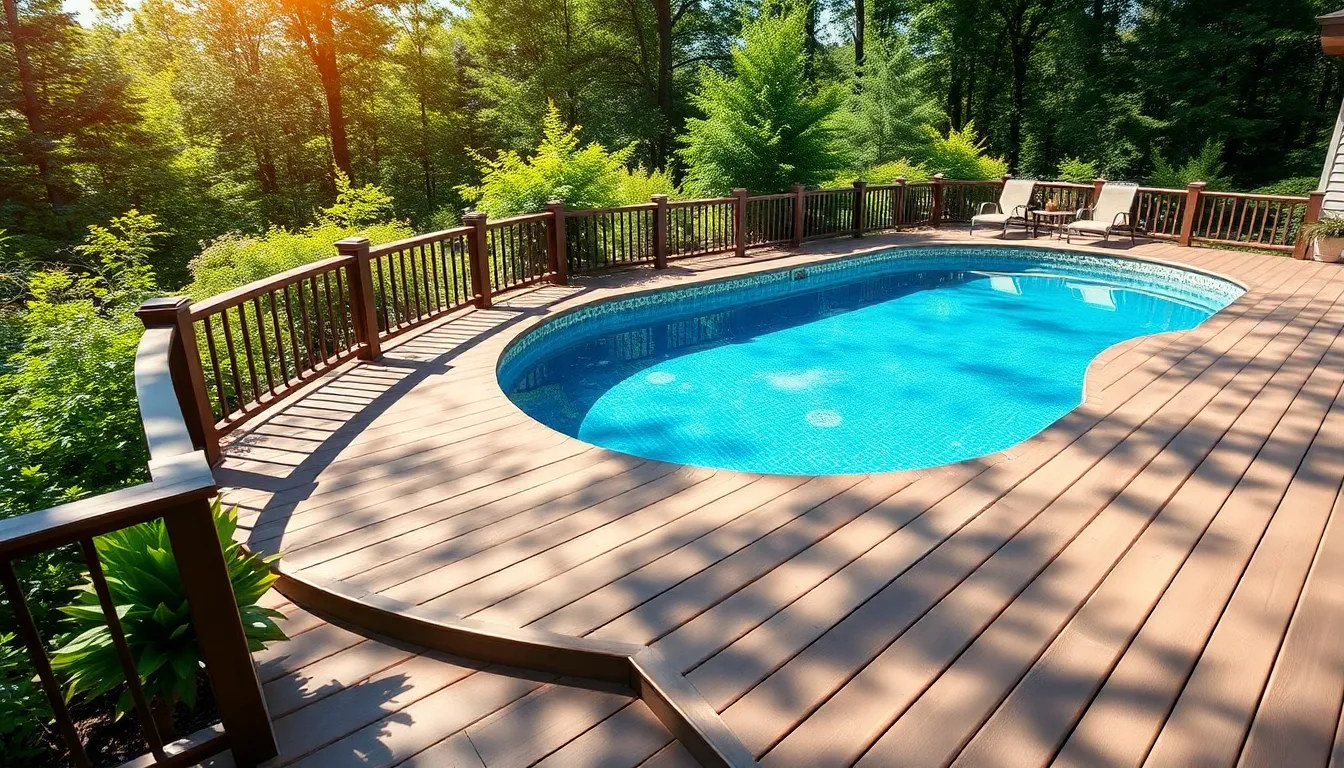
We’ve covered creative designs and space-saving answers, but choosing the right decking material can dramatically reduce your maintenance workload while keeping your poolside retreat looking pristine year after year.
Composite Decking Benefits
Composite decking transforms your pool deck maintenance routine with its innovative blend of wood fibers and plastic materials. Unlike traditional wood, this engineered solution resists rot, splintering, and insect damage without requiring annual painting or staining treatments. Available in various colors and textures, composite boards mimic natural wood’s appearance while delivering superior durability that withstands constant pool splashing and chemical exposure.
Maintenance becomes effortless since composite materials require only occasional cleaning with soap and water to maintain their appearance. The initial investment pays dividends over time as you’ll avoid costly refinishing projects that traditional wood demands every few years. Safety improves significantly because composite surfaces resist splintering, protecting bare feet around wet pool areas where slips and falls are common concerns.
PVC and Vinyl Alternatives
PVC and vinyl decking materials excel in pool environments where moisture exposure creates ongoing challenges for traditional materials. These synthetic options resist moisture penetration, UV fading, and mold growth that typically plague wooden decks in humid poolside conditions. Manufacturers design PVC boards to replicate wood grain patterns and natural textures, providing aesthetic appeal without wood’s inherent vulnerabilities.
Installation proves straightforward since PVC materials are lightweight yet structurally sound for pool deck applications. Cleaning requires minimal effort as these surfaces resist staining from pool chemicals, sunscreen, and outdoor elements that commonly discolor other materials. Long term performance remains consistent because PVC won’t warp, crack, or deteriorate from constant moisture exposure like traditional decking options.
Weather-Resistant Wood Treatments
Pressure-treated lumber remains a cost-effective choice for pool decks when properly protected with weather-resistant treatments and maintenance protocols. Modern wood preservatives, stains, and sealants create protective barriers against moisture infiltration and UV damage that extend deck lifespan significantly. Water-repellent treatments should be reapplied every 2-3 years to maintain optimal protection levels.
Professional-grade stains penetrate deep into wood fibers while forming surface barriers that repel pool chemicals and rainwater. Semi-transparent stains allow wood’s natural beauty to show through while providing essential protection, making them ideal for homeowners who prefer natural aesthetics. Regular maintenance schedules including annual cleaning and periodic stain touch-ups ensure treated wood decks deliver years of reliable service around your above-ground pool installation.
Safety Features for Small Pool Deck Installations

Installing proper safety features on your small above-ground pool deck isn’t just a smart choice—it’s essential for protecting your family and guests. We’ll explore the critical safety elements that transform your deck into a secure and enjoyable outdoor space.
Proper Railing Requirements
Building codes require railings around the entire perimeter of elevated pool decks to prevent falls and provide stability. Most local building codes mandate a minimum height of 36-42 inches for deck railings, ensuring adequate protection for users. We recommend securing railings directly to the deck frame using appropriate fasteners that can withstand the pressure of someone leaning against them.
Sturdy railing systems serve multiple functions beyond basic safety compliance. They provide essential support when entering or exiting the pool area, particularly for elderly family members or guests with mobility concerns. Installing gates at stair entrances adds another layer of security by controlling access and preventing unsupervised pool use.
Proper installation techniques ensure your railings remain secure over time. We suggest using galvanized bolts and brackets that resist corrosion in the humid pool environment. Spacing balusters no more than 4 inches apart prevents small children from slipping through gaps while maintaining the deck’s visual appeal.
Non-Slip Surface Answers
Choosing the right decking material significantly reduces slip and fall risks on wet surfaces. Composite wood decking offers excellent traction even when wet, while treated lumber with textured finishes provides natural grip without compromising aesthetics. Anti-slip coatings can be applied to existing smooth surfaces to enhance safety without requiring a complete deck replacement.
Strategic design elements improve water drainage and reduce surface slipperiness. Leaving small gaps between decking boards allows water to drain quickly rather than pooling on the surface. Sloping the deck slightly away from the pool ensures water flows toward drainage points instead of collecting in problem areas.
Textured materials and finishes create safer walking surfaces without sacrificing style. Scrap wood decks with proper finishing provide excellent traction while maintaining a natural aesthetic that complements outdoor settings. Grooved or ribbed decking boards offer additional grip while still looking polished and intentional.
Lighting Integration Options
Recessed deck lights illuminate pathways and prevent trips while creating an inviting evening atmosphere. Installing these fixtures directly into the deck surface provides clean lines and reduces tripping hazards that protruding lights might create. LED strip lights along railings and stairs offer continuous illumination that clearly defines edges and boundaries.
Solar-powered lighting answers reduce installation complexity while providing reliable nighttime visibility. Post cap lights require no electrical wiring and automatically turn on at dusk to guide guests safely around the deck perimeter. Underwater pool lights create ambient effects that enhance the overall poolside experience while improving water visibility.
Proper lighting placement ensures complete coverage of high-risk areas without creating glare. We recommend spacing lights every 6-8 feet along walkways and positioning them to illuminate each step clearly. Motion-activated options conserve energy while providing instant illumination when someone approaches the pool area after dark.
Creative Design Elements for Compact Pool Decks

Adding distinctive features to your small above-ground pool deck transforms an ordinary setup into a personalized outdoor retreat. We’ll explore key design elements that enhance both functionality and style while maximizing your limited space.
Privacy Screen Additions
Lattice panels create instant privacy while maintaining airflow around your pool area. We recommend installing bamboo fencing or wooden slats along the deck’s perimeter to block unwanted views and establish an intimate atmosphere for relaxation.
Vertical gardens serve dual purposes by providing privacy screening and natural décor elements. Trellises with climbing plants like ivy, clematis, or morning glories create living walls that grow more beautiful over time while shielding your pool space from neighbors.
Fabric screens offer flexible privacy answers that adapt to changing needs throughout the day. Outdoor curtains attached to pergola posts or deck railings provide adjustable seclusion and can be drawn back when you want an open feel.
Bamboo roll-up screens mount easily to existing structures and roll down for instant privacy or up for unobstructed views. These lightweight options work particularly well for rental properties or temporary installations.
Pergola and Shade Structures
Pergolas define your pool lounge area while providing stylish overhead coverage from harsh sunlight. We suggest positioning pergolas to cover seating areas and pool entry points where you’ll spend the most time during peak sun hours.
Retractable canopies attached to pergola frames allow adjustable sun protection throughout the day. Canvas or fabric panels can be extended during intense afternoon heat and retracted for stargazing in the evenings.
Shade sails complement pergola structures or work independently to keep deck surfaces cool and comfortable. Triangle or square sails mounted at different heights create visual interest while providing essential UV protection.
Combination structures merge pergolas with outdoor kitchens or wet bars to create complete entertainment zones. These integrated designs maximize functionality within your compact space while establishing clear activity areas.
Decorative Railing Styles
Horizontal wooden railings maintain a clean, minimal aesthetic while staying within budget constraints. Simple designs using pressure-treated lumber create safety barriers without overwhelming your small deck’s proportions.
Cable railings add modern sophistication while preserving unobstructed pool views. Stainless steel cables stretched between posts create sleek lines that make your deck appear larger and more open.
Built-in lighting integrated into railing posts enhances evening ambiance and improves safety around water areas. LED strip lights or individual post caps illuminate pathways and highlight deck boundaries after dark.
Custom painted railings can be coordinated with your pool liner colors or house trim for cohesive design appeal. Contrasting colors like white railings against dark decking create visual definition and architectural interest.
Conclusion
Creating the perfect deck for your small above ground pool doesn’t require a massive budget or extensive construction experience. We’ve shown you how thoughtful planning and creative design choices can transform even the most compact spaces into stunning outdoor retreats.
Whether you choose a multi-level platform design or opt for space-saving corner configurations the key lies in maximizing both functionality and style. Remember that safety features and low-maintenance materials will ensure your investment provides years of enjoyment.
Your small pool deck can become the centerpiece of your backyard oasis. With the right combination of storage answers creative elements and quality materials you’ll create a space that rivals any expensive in-ground pool setup while staying within your means.
Frequently Asked Questions
What is the minimum space needed for a small above-ground pool deck?
The exact space requirements depend on your pool size and desired deck configuration. However, even the smallest yards can accommodate pool decks through corner installations, single-side access designs, or compact entry points. L-shaped corner configurations and angled deck layouts are particularly effective for maximizing limited space while maintaining functionality and safety.
How much does a DIY small pool deck typically cost?
DIY small pool decks can range from $500-$3,000 depending on materials and size. Pressure-treated lumber offers the most budget-friendly option, while composite decking represents a higher upfront investment but lower long-term maintenance costs. Using recycled materials can significantly reduce costs while creating unique, personalized features.
What materials are best for small pool decks?
Composite decking is ideal for low maintenance, resisting rot and splintering. Pressure-treated lumber offers excellent value and durability when properly maintained. PVC and vinyl alternatives provide superior moisture resistance. For budget-conscious projects, reclaimed wood can create unique features while reducing costs significantly.
Do I need permits for a small above-ground pool deck?
Permit requirements vary by location and deck height. Decks over 30 inches high typically require permits and must meet local building codes. Always check with your local building department before starting construction. Railings are usually required for decks exceeding 30 inches in height for safety compliance.
How can I maximize storage in a small pool deck design?
Incorporate built-in benches with hidden storage compartments, under-deck storage areas with weatherproof access panels, and pull-out drawer systems for smaller items. Corner bench configurations maximize seating while providing storage. Dedicated pump enclosures and filter housing compartments can hide equipment while maintaining easy maintenance access.
What safety features should I include in my pool deck?
Install proper railings meeting height requirements (typically 36-42 inches), use non-slip surface materials or treatments, and integrate adequate lighting around the pool area. Recessed lights and solar-powered fixtures enhance visibility. Textured decking materials and strategic design elements help reduce slip risks in wet conditions.
How do I maintain a small pool deck?
Maintenance depends on materials chosen. Composite decking requires only occasional cleaning with soap and water. Pressure-treated lumber needs annual weather-resistant treatments and regular inspection for damage. All decks benefit from regular debris removal, proper drainage maintenance, and seasonal deep cleaning to prevent moisture damage.
Can I build a multi-level deck for my small pool?
Yes, multi-level designs are excellent for small spaces. Two-tier configurations create distinct zones for dining and pool access. Built-in stepped seating maximizes social areas without bulky furniture. Graduated height platforms create visual interest while providing smooth transitions between different activity zones and improving overall functionality.

